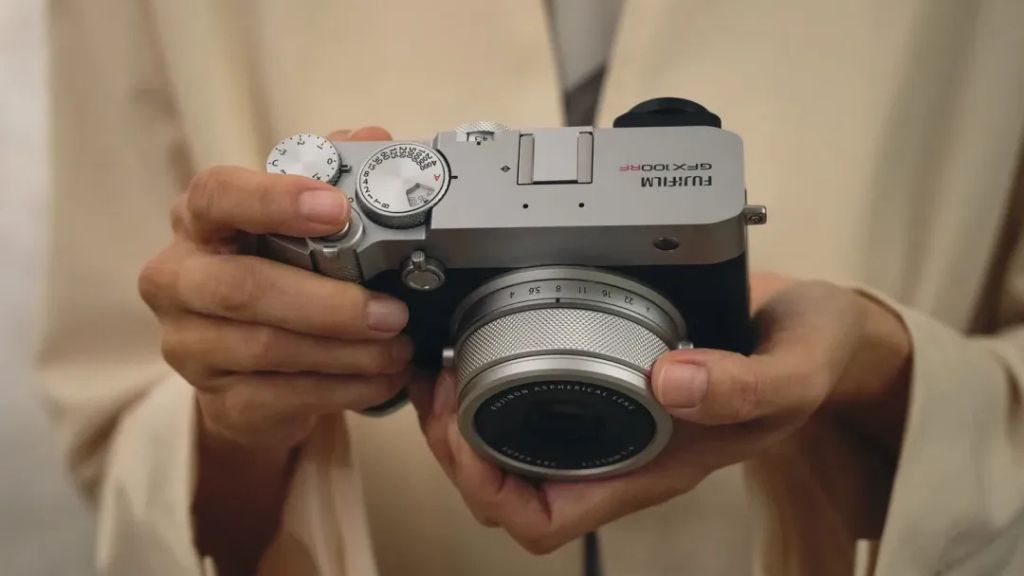Photography fans, hold onto your hats—Fujifilm just dropped a game-changer! On March 20, 2025, the company introduced the GFX100RF, a medium format camera that’s turning heads with its compact size and fixed-lens design. Imagine the jaw-dropping detail of a 102-megapixel sensor packed into a body that’s lighter than ever in Fujifilm’s GFX lineup.
Oh, and did we mention it’s taking a bold swing at the Leica Q3? If you’re a shutterbug who loves stunning images without lugging around a heavy kit, this might just be your dream camera. Let’s dive into what makes the GFX100RF so special in this friendly, detailed breakdown!
A Fresh Twist on Medium Format Magic
Fujifilm’s GFX series has always been about delivering incredible image quality with medium format sensors, but the GFX100RF takes things to a whole new level. Unlike its siblings, this camera comes with two standout features: it’s the lightest GFX model yet, tipping the scales at just 1.62 pounds (735 grams), and it’s the first in the lineup to sport a fixed lens. That lens? A 35mm beauty (equivalent to 28mm in full-frame terms), chosen for its do-it-all versatility.
Read Aso: Pixel 9A Delayed Drama: What’s Google Hiding with This Mystery Component?!
This isn’t just a technical marvel—it’s a style statement. The GFX100RF borrows some design vibes from Fujifilm’s wildly popular X100VI, blending sleek looks with pro-level performance. With a top plate carved from a single block of aluminum, it’s as gorgeous as it is tough. Set to hit shelves in April 2025 for $4,899.95, it’s not cheap, but for a medium format camera this portable, it’s a tempting deal. At that weight, it’s in the same league as some full-frame champs like the Sony A1 II—pretty impressive for a medium format contender!
Compact Design Meets Big Sensor Power
Let’s talk about that sensor—102 megapixels of pure goodness! That’s the kind of resolution that captures every tiny detail, from the texture of a leaf to the sparkle in someone’s eye. Pair it with the fixed 35mm f/4 lens, and you’ve got a combo that’s ready for anything—street photography, landscapes, or even portraits with a bit of creativity. Fujifilm says the lens can focus as close as 20 centimeters, perfect for those artsy close-up shots.

Here’s a cool trick: the camera lets you “extend” the focal length digitally to 45mm, 63mm, or 80mm. Okay, it’s technically a crop, but with a sensor this huge, you’ve got plenty of pixels to play with. It’s a handy feature for framing shots without needing extra lenses. The lens itself is no slouch either—built with ten elements in eight groups, including two aspherical lenses, it promises sharp, vibrant images.
But there’s a catch—no in-body image stabilization (IBIS). For a camera this pricey, that might raise some eyebrows, especially since you’ll likely be shooting handheld a lot. Fujifilm probably skipped IBIS to keep the size down, and they’ve worked some engineering magic to make it happen. More on that in a bit!
Smart Engineering for a Smaller Footprint
So, how did Fujifilm shrink a medium format camera into something this portable? It’s all about clever design choices. Instead of the usual focal plane shutter, the GFX100RF uses a leaf shutter system. This shortens the back focus distance, freeing up space inside the body. Combine that with a streamlined layout of the lens and components, and voilà—you’ve got a medium format camera that doesn’t feel like a brick.
That leaf shutter isn’t just for show—it also lets you sync a flash at any shutter speed, a boon for photographers who love playing with light. Whether you’re shooting in bright daylight or a dimly lit studio, this feature gives you flexibility that’s hard to beat.
Dials, Filters, and Fujifilm Flair
Fujifilm knows how to make cameras fun to use, and the GFX100RF is no exception. One of its coolest additions? An aspect ratio dial right on the body. With a quick twist, you can switch between nine different ratios—think 3:2, 16:9, 1:1, or even the cinematic 17:6. It’s a hands-on way to get creative without diving into menus.
Another first for the GFX series: a built-in four-stop ND filter. That’s a game-changer for shooting in bright conditions or nailing those silky long-exposure shots without extra gear. Fujifilm’s clearly thought about the little details that make a big difference.
On the back, you’ll find a 3.15-inch touchscreen LCD with 2.1 million dots—plenty sharp for reviewing shots or framing on the fly. Prefer a viewfinder? The 5.76-million-dot electronic viewfinder (EVF) is a treat, delivering crisp, clear visuals. If you’ve ever used a Fujifilm X-H2, you’ll know how good this EVF is—it’s like looking through a window to your scene.
How It Stacks Up: GFX100RF vs. Leica Q3
Fujifilm isn’t shy about who they’re targeting here—the Leica Q3, a fixed-lens full-frame darling, is clearly in the crosshairs. Both cameras aim for photographers who want premium quality in a compact package, but the GFX100RF brings a medium format edge. That 102MP sensor blows the Leica’s 60MP out of the water in terms of detail, and the 28mm-equivalent lens is just as versatile as the Q3’s 28mm offering.
Price-wise, the GFX100RF’s $4,899.95 isn’t far off from the Leica Q3’s premium tag, but you’re getting a bigger sensor for your money. The trade-off? No IBIS and a fixed lens mean you’re locked into Fujifilm’s vision. If you crave interchangeable lenses, Fujifilm’s own GFX 100S II might tempt you instead—it’s heavier but offers IBIS and more flexibility.
Who’s This Camera For?
The GFX100RF is a niche beast, and that’s okay! It’s perfect for photographers who want medium format quality without the bulk—think street shooters, travel buffs, or anyone obsessed with detail. At 1.62 pounds, it’s portable enough to carry all day, and the fixed lens keeps things simple. No fumbling with lens swaps—just point, shoot, and marvel at the results.
That said, the lack of IBIS might frustrate some, especially at this price. If you’re shooting in low light or need rock-steady shots handheld, you’ll have to lean on fast shutter speeds or a tripod. For $4,899.95, it’s a big investment, but if you’ve got deep pockets and a love for Fujifilm’s signature look, it could be worth every penny.
Why We’re Excited (And a Little Curious)

There’s a lot to love about the GFX100RF. The lightweight build, stunning sensor, and thoughtful extras like the ND filter and aspect ratio dial make it a joy for creative minds. It’s Fujifilm flexing its muscles, showing they can blend compact design with pro-grade power. Plus, that X100VI-inspired aesthetic? It’s a camera you’ll want to show off.
But we’ve got questions too. How will it perform without IBIS in real-world shooting? Can that fixed lens hold its own against interchangeable options? We’re itching to get our hands on one for a full review, so stay tuned for the nitty-gritty details!
When Can You Get It?
Mark your calendars—the Fujifilm GFX100RF hits stores in April 2025. At $4,899.95, it’s a splurge, but for a medium format camera this portable, it’s a fair ask. Whether you’re a pro looking to lighten your load or an enthusiast chasing the ultimate image quality, this could be your next big buy.
Read Also: PepsiCo’s Big Move: Snagging Poppi for Nearly $2 Billion – What’s the Buzz All About?
Final Thoughts: A Bold Step Forward
The Fujifilm GFX100RF is proof that medium format doesn’t have to mean massive. It’s a bold, beautiful camera that dares to challenge the likes of the Leica Q3 while carving its own path. Sure, it’s not perfect—IBIS would’ve been the cherry on top—but what it does, it does with style and substance.
So, what do you think? Are you tempted to add this compact powerhouse to your kit? Or are you holding out for something with more bells and whistles? Drop your thoughts below—we’d love to hear from you!
